Gum Disease Treatment – Chesterfield, MO
Healing & Managing Your Infected Gums

As crucial as they are, your teeth aren’t the only big players in oral health. Your gum tissues also play a vital role in your smile, keeping it strong and functional over time. It’s for that reason that our practice offers quality gum disease treatment here in Chesterfield. Through this procedure, Dr. Yenzer and the rest of our team can help your gums work as they should. Learn more about it by reading below or by visiting our office.
Why Choose Yenzer Family Dental of Chesterfield for Gum Disease Treatment?
- State-of-the-Art Laser Treatment
- Dentist with 20+ Years of Experience
- Caring & Friendly Dental Team
What is Gum Disease?
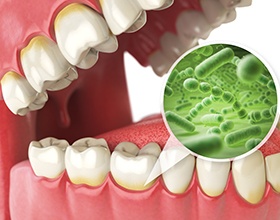
At its core, gum disease is an infection of your gums – the soft tissues around your teeth. It occurs when excess plaque builds in your mouth from poor eating, bad oral care, etc. That said, certain factors like genetics, tobacco use, and hormone changes can put you at greater risk.
Gum disease has two distinct stages: gingivitis and periodontitis. The first refers to mild gum inflammation that’s often irritating but reversible. Meanwhile, periodontitis is a full-blown infection that directly attacks your gum and jaw tissues. This second form is irreversible; it can only be managed at best.
Symptoms of Gum Disease
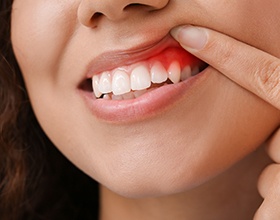
Since it has two stages, gum disease can have a wide range of symptoms. Which signs you show will depend on your condition’s severity and onset.
Just look at gingivitis, for example. This first stage of gum disease has symptoms like:
- Gum tenderness
- Gum swelling
- Bleeding gums
- Dark red gums
- Gum recession
- Halitosis (i.e., chronic bad breath)
In contrast, the symptoms for periodontitis tend to be more severe. They include:
- Tooth sensitivity (often due to gum recession)
- Loose permanent teeth
- A shift in your bite
- Changes in your restoration’s fit
- Chewing pain
- Permanent tooth loss
How Do We Treat Gum Disease?

Before moving forward with care, Dr. Yenzer will give your mouth an oral exam. This step lets him closely assess your gums – whether they’re sensitive, inflamed, etc. He’ll then use his findings to decide on possible treatment options, such as:
Laser Periodontal Treatment
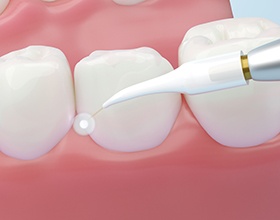
Looking for a minimally invasive way to treat your gum disease? Depending on the specifics of your case, we may determine that you’re a candidate for laser periodontal treatment. With a state-of-the-art GEMINI soft tissue laser, we can precisely treat the parts of your mouth where gum disease is present while leaving healthy tissue alone. Read on for a closer look at what you can expect from laser periodontal treatment.
How Laser Periodontal Treatment Works
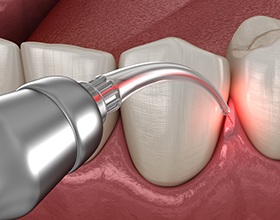
A soft-tissue laser emits a highly concentrated beam of light that can be used to gently remove inflamed gum tissue. During this process, the energy from the laser can kill harmful oral bacteria, thus giving your mouth a chance to heal. On top of that, the laser can also help with removing built-up plaque and smoothing out the roots of the teeth.
The Benefits of Laser Periodontal Treatment

Using a laser to treat gum disease comes with many important benefits for the patient:
- Enhanced Precision: A soft-tissue laser is much more precise than traditional dental instruments, which helps ensure that our team doesn’t remove any more tissue than necessary. This typically results in a more comfortable procedure as well as less bleeding and swelling afterward.
- Faster Recovery Times: Compared to traditional gum surgery, laser periodontal treatment doesn’t require nearly as much recovery time afterwards. Under normal circumstances, you should be able to resume your regular routine after just a day or two of rest.
- Lower Risk of Future Infection: A soft-tissue laser can help sterilize your mouth, which ultimately makes it less likely for future infections to occur.
- Improved Gum Health Overall: Removing infected tissue along with harmful bacteria can go a long way toward getting the health of your gums back on track.
Aftercare Tips for Laser Periodontal Treatment

Once your laser periodontal treatment is complete, we’ll give you some tips for taking care of your mouth until it heals. Here’s a brief look at some of the steps you’ll need to take:
- Plan your diet carefully. You’ll need to make a point of avoiding any foods that are particularly hard, sticky, crunchy, hot, or spicy. Instead, stick to nutritious soft or liquid foods; this can include mashed potatoes, applesauce, scrambled eggs, and non-hot soups.
- Make a point of avoiding heavy lifting or any other kind of strenuous physical activity that can increase bleeding and interfere with the healing process.
- Keep your mouth clean to reduce the chances of an infection occurring during the recovery process. A good way to do so is to rinse with salt water multiple times a day. You can still brush and floss like you normally would as long as you avoid the area where the treatment was performed.
- When you lie down to go to sleep, make sure that your head stays slightly elevated in order to keep bleeding and swelling to a minimum.
Scaling & Root Planing
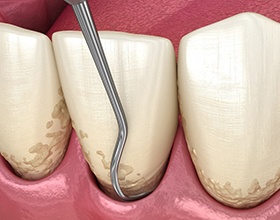
The more standard treatment for gum is scaling and root planing. With this procedure, a dentist performs a two-part “deep cleaning” that removes plaque from your teeth and gums. The scaling uses an ultrasonic cleaner to remove plaque and deposits beneath your gumline. Meanwhile, the following “root planing” smoothes out your tooth roots so your gums can reattach healthily. For more details on these steps, please keep reading or call us soon.
Do I Need Scaling & Root Planing?

Ultimately, only a dentist will know whether you need scaling and root planing. They can check your mouth for signs that you’d benefit from treatment, including:
- Sensitive or bleeding gums
- Gum swelling or puffiness
- A visible buildup of plaque
- Receding gum tissue
- Persistent bad breath (i.e., halitosis)
The above signs can often be reversed with oral care, but you’ll need scaling and root planing if your infection is severe. Only treatment would manage your symptoms at that point.
The Process of Scaling & Root Planing
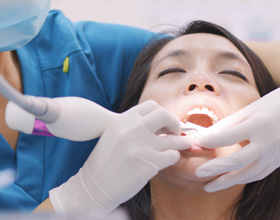
In general, scaling and root planning are done over two dental visits. Scaling always occurs at the first session, while the second performs the root planing.
Dr. Yenzer will do the initial scaling at your first treatment visit. In particular, he’ll use an ultrasonic scaler to remove plaque and tartar from the surfaces of your teeth. He’ll also move as far down as your gum pockets to ensure effective results.
The “root planing” will occur during your second visit. At that time, we’ll remove any hard bacterial deposits clinging to your tooth roots. We’ll then smooth those roots so your gums can reattach well, reducing your risk of re-infection as a result.
Aftercare Tips for Scaling & Root Planing

Your teeth and gums will need weeks to recover from treatment, as scaling and root planing can be invasive. You’ll also feel some aches and pains during this healing process. That said, you can cope with these effects by using the following tips:
- Eat Meals Carefully – For the first 48 hours after treatment, follow a soft food diet to prevent irritated gums. Avoid spicy foods, alcohol, and acidic drinks for a few weeks as well.
- Rest & Relax – As best you can, don’t perform intense physical work right after treatment. Moving around too much would delay your healing progress.
- Rinse with Salt Water – Do salt water rinses for your gums after your meals. By doing so, you’ll reduce your gums’ irritation and loosen debris around your teeth.
- Brush Gently – For a few days after treatment, gently brush your teeth with a soft-bristled toothbrush. Brushing in slow and circular motions will prevent aches and pains in your gums.

